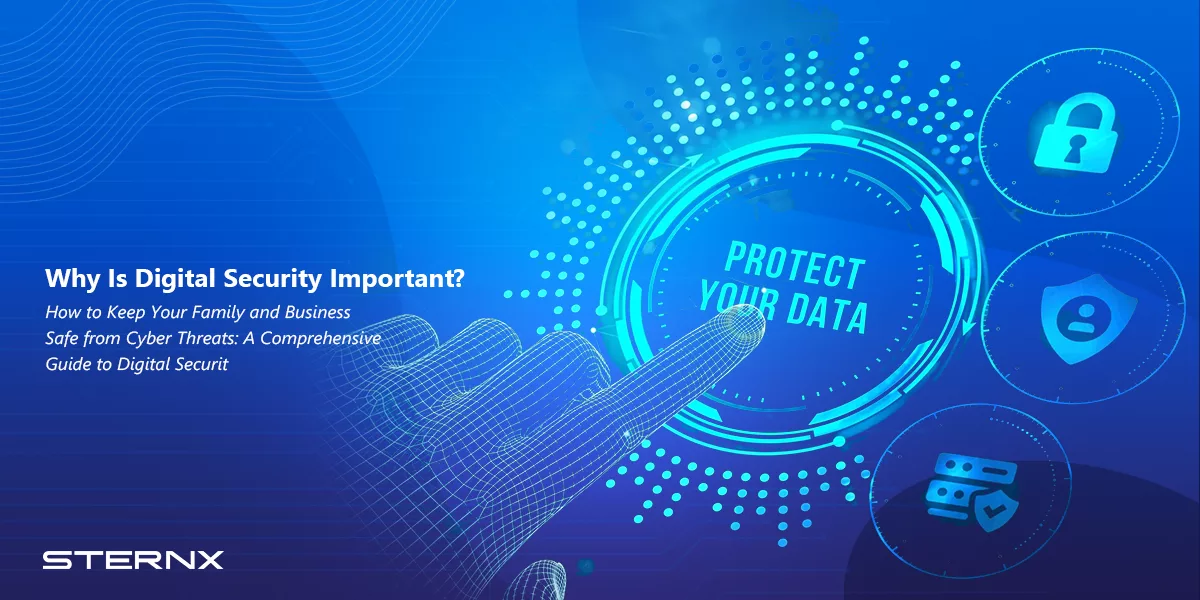Table of Contents
Ever heard about that one guy who had his smart fridge hacked? True story! With more connected devices than ever before, digital security is a hot topic. Did you know that cybercrime costs the global economy over $1 trillion annually? Yup, that’s a trillion with a ‘T.’ Why the importance of digital security? For starters, it’s about keeping your personal information safe from prying eyes. Think of it as a virtual lock and key for your online life. But it’s not just your privacy at stake.
Your financial assets are on the line, too. Imagine waking up to find your bank account wiped clean. That’s why digital security is crucial. It ensures your sensitive information remains confidential and your online activities stay private. In today’s digital age, protecting yourself online is as important as locking your front door at night.
So, what is digital security, anyway? In simple terms, it’s the practice of protecting sensitive information, your online identity and personal data from cyber threats. As we live our lives online, from shopping to socializing, safeguarding our digital presence has become an important task.
What Are Digital Threats?
Welcome to the wild world of digital threats! From sneaky malware to devious phishing schemes, let’s break down the most common cyber dangers and how to outsmart them.
Malware Mayhem
It is a nasty software designed to harm your device and network security. Viruses, ransomware, and spyware fall under this umbrella. You can protect yourself by installing reputable antivirus software, keeping your system updated, and avoiding suspicious downloads. Think of it as digital hygiene – clean devices are happy devices.
Phishing Attacks
Phishing attacks trick you into giving away personal info through fake emails or websites. These scams often look legit but can be spotted by checking the sender’s address and looking for grammar mistakes. When in doubt, don’t click! Better safe than scammed.
Social Engineering Shenanigans
Social engineering involves manipulating people into revealing confidential information. Attackers might pose as tech support or even friends. Be cautious with unsolicited requests for info. Verify identities through a separate contact method.
Password Problems
Weak passwords are a hacker’s dream. Use strong, unique passwords for every account. Combine upper and lowercase letters, numbers, and symbols. A password manager can help keep track of them. Your pet’s name plus “123” won’t cut it anymore.
Unsecure Wi-Fi
Unsecured Wi-Fi networks open doors for cybercriminals. Always use a strong password for your home Wi-Fi. When out and about, avoid public Wi-Fi for sensitive activities like banking. A virtual private network (VPN) adds an extra layer of security. Stay connected, but stay safe!
The Risks of Inadequate Digital Security
You might be wondering what some of the dangers of not having robust digital security might be? This isn’t just about losing data; it’s about real-life consequences.

Identity Theft
Identity theft is when someone steals your personal information to commit fraud. It can lead to drained bank accounts, ruined credit, and countless hours spent on recovery. For instance, according to Cloudwards, in 2023, identity theft victims in the U.S. reported losses exceeding $1.8 billion.
Financial Fraud and Scams
Financial fraud includes credit card fraud, investment scams, and phishing attacks. These scams can devastate victims emotionally and financially. For example, Couldwards reports that phone phishing scams alone cost Americans $40 billion in 2022. The emotional toll of such scams can be overwhelming, leading to stress and anxiety.
Privacy Invasion and Personal Data Exposure
Privacy invasions happen when unauthorized parties access your personal data. This can occur through data or security breaches or inadequate privacy settings on social media. Having your data exposed can lead to identity theft, blackmail, or even physical danger. With the average data breach reportedly costing companies $4.45 million in 2023, it’s clear that protecting personal information customer data is critical.
Cyberbullying and Online Harassment
Cyberbullying involves using digital platforms to harass or intimidate others. It can significantly impact children and teenagers, leading to anxiety, depression, and even suicidal thoughts. Studies show that around 59% of U.S. teens have experienced some form of cyberbullying. Open communication and monitoring online activities can help mitigate these risks.
The Impact on Businesses and Organizations
Inadequate security doesn’t just hurt individuals; it affects businesses too. Significant breaches, like the 2023 ransomware attack on Costa Rica, which crippled government operations, showcase the wide-reaching impacts. These incidents can result in massive financial losses, reputational damage, and operational disruptions.
Best Practices for Digital Security
Ready to fortify your digital life? Here are some healthy tech habits to keep your family safe online.
- Antivirus and Anti-Malware :Antivirus and antimalware software are your first line of defense against cyber threats. Look for features like real-time scanning and automatic updates. Top picks include Norton and Bitdefender. A robust program can be your digital watchdog, keeping those pesky viruses at bay.
- Password Power:Creating strong, unique passwords is key. As mentioned before, mix uppercase, lowercase, numbers, and symbols. Avoid obvious choices like “password123.” Use a password manager to keep track of your credentials. These tools store and generate complex passwords, making your digital life easier and more secure.
- Two-Factor Authentication: Two-factor authentication (2FA) adds an extra security layer. It requires a second form of verification, like a code sent to your phone. Set it up on critical accounts like email and banking. This makes hacking significantly harder and keeps your information safer.
- Regular Updates: Regular software updates are essential for security. Outdated software is an open door for hackers. Enable automatic updates on your devices. For manual updates, set a monthly reminder. Keeping your software current is one of the keys to digital security.
- Browse With Caution: One of the healthy tech habits is safe browsing. Safe browsing habits can prevent many cyber mishaps. Stick to reputable websites and be wary of unsolicited links. Look for “https” in the URL for secure sites. Avoid downloading files from unknown sources. Think before you click to dodge digital danger.
- Parental Controls: Parental controls are a must to protect your kids online. Tools like Safes Parental Control, our products at SternX Technology allow you to monitor and restrict online activities. Parental control apps help you set time limits, block inappropriate content, and track usage. These controls help create a safe and healthy digital environment for your little ones.
Protecting Personal Data and Privacy
Ready to be a digital superhero? Here are some practical tips to protect personal data and privacy.
- Data Encryption: Data encryption is like a secret code for your information. It transforms your data into unreadable gibberish for anyone without the key. Encryption is essential for safeguarding personal information, especially during online transactions. Use tools like encrypted messaging apps and secure websites to keep your data locked up tight.
- Becoming Social Media Savvy: Social media can be a goldmine for cyber snoops. Sharing too much can expose you to identity theft and other risks. Protect your personal information by being selective about what you post. Use strong privacy settings and avoid sharing sensitive details like your home address or vacation plans.
- Privacy Settings: Managing privacy settings on online platforms is crucial. Regularly check and adjust your settings to control who sees your information. Follow practices like limiting profile visibility and turning off location sharing. Staying on top of these settings helps maintain your online privacy.
- VPN: Your Invisible Cloak: Virtual Private Networks (VPNs) are your best allies for protecting online privacy. They encrypt your internet connection, making it harder for others to spy on your online activities. Choose a reputable VPN service and use it, especially on public Wi-Fi. With a VPN, your data stays under wraps.
Securing Financial Transactions Online
Let’s explore how to keep your money safe while navigating the internet. By following the following tips, you can enjoy the convenience of online transactions while keeping your financial information secure.
- Recognizing Secure Payment Gateways: Secure payment gateways are your first line of defense. Look for features like SSL certificates, encryption, and PCI-DSS compliance. To verify their security, check for “https://” in the URL and look for trust seals from reputable security companies. These indicators show the site is taking steps to protect your financial data.
- Safe Online Shopping: Online shopping should be convenient, not risky. Stick to well-known retailers and avoid deals that seem too good to be true. Use credit cards instead of debit cards for better fraud protection and ensure the website uses secure payment methods. Recognize scams by checking reviews and verifying the seller’s contact information.
- Online Banking and Financial Accounts: Securing your online banking starts with using strong, unique passwords and enabling multi-factor authentication. Regularly update your security settings and monitor your accounts for any suspicious activity. Avoid accessing your financial accounts on public Wi-Fi networks to reduce the risk of data interception.
Common Myths About Digital Security
Think you know digital security? Let’s bust some common myths about digital security.
Myth 1: Antivirus Software Alone Is Enough
Antivirus software is important, but it’s just one piece of the puzzle. Cybersecurity needs a multi-layered approach, including firewalls, encryption, and safe browsing habits. Think of it like a home security system – you need more than a door lock to keep intruders out.
Myth 2: Only Big Companies Are Targets of Cyber Attacks
Cybercriminals don’t only go after big fish. Individuals and families are prime targets, too. From phishing emails to ransomware attacks, everyday people face real threats. Protect your household by staying informed and vigilant. Remember, cybercriminals love easy prey – don’t be one.
Myth 3: Strong Passwords Are Too Difficult to Manage
Managing strong passwords is easier than you think. Use a password manager to generate and store complex passwords. This tool keeps your credentials safe and accessible. No need to remember everything – let the password manager do the heavy lifting while you focus on healthy tech habits.
Myth 4: Public Wi-Fi Is Safe Enough for Simple Browsing
Public Wi-Fi might be convenient, but it’s far from safe. Hackers can easily gain access or intercept data on unsecured networks. Always use a VPN when connecting to public Wi-Fi to encrypt your data and protect your privacy from security risk. It’s like having a personal bodyguard for your online activities.
Myth 5: Cybersecurity Threats Are Easy to Spot
Many believe they can easily identify cyber threats, but modern attacks are sophisticated and deceptive. Phishing emails can look convincingly legitimate, and malware can hide in plain sight. Regularly educate yourself and your family or business about the latest threats to stay one step ahead of cyber criminals.

The Role of Education in Digital Security
Keeping your family safe online starts with education. Here, we’ll explore how to arm both kids and parents with the knowledge they need to navigate the digital world safely.
Teaching Children About Online Safety
Teaching children about online safety should be fun and engaging. For younger kids, use simple language and analogies, like comparing online strangers to real-life strangers. For teens, discuss the risks of sharing personal information and the importance of healthy tech habits. Encourage open communication about their online activities. Make sure they feel comfortable coming to you with any concerns or questions about digital security.
Emphasize the importance of not sharing passwords and recognizing suspicious behavior online. Use interactive tools and games designed for kids to reinforce these lessons. Remember, the goal is to make them feel empowered and informed, not scared.
Digital Literacy for Parents
Parents should know teaching digital literacy isn’t just for kids, they also need to stay informed too. There are plenty of resources and courses available, from online tutorials to community workshops. Improving your digital literacy helps you understand the risks and protections needed for your family. Knowledgeable parents can set a strong example and enforce smart online habits at home.
School and Community Programs
Schools and communities play a crucial role in promoting digital safety. Many offer programs that teach students and parents about cyber threats and safe practices. These initiatives often include workshops, seminars, and interactive activities designed to make learning about digital security engaging and accessible. Participating in these programs can help reinforce what you’re teaching at home and build a community of digitally literate families.
Tools and Resources for Enhancing Digital Security
Securing your digital life can seem daunting, but with the right tools and resources, it’s manageable and even easy. Incorporating these tools and resources into your daily routine can significantly enhance your digital security.
Recommended Software and Apps
When it comes to essential cybersecurity tools, there are a few standouts every family should consider. For instance, SternX offers a robust parental control product that helps monitor and manage your children’s online activities, ensuring they stay safe while surfing the web.
Look for features like real-time scanning, automatic updates, and user-friendly interfaces when choosing security tools. For example, Norton and Bitdefender are known for their strong malware protection and easy-to-use platforms. Password managers can simplify the process of maintaining strong, unique passwords for all your accounts, adding an extra layer of security.
Online Resources and Guides
Staying informed about digital security is crucial. Websites like Trio offer up-to-date information on the latest threats and security practices. For in-depth guides and tutorials, check out the National Cyber Security Centre’s resources. These platforms provide step-by-step instructions on implementing security measures effectively.
Support Services
Professional support services, such as those offered by SternX, are invaluable for navigating complex digital security challenges. These services provide expert advice, help with setting up security systems, and offer ongoing support to ensure your devices remain protected. Accessing these services is simple – visit the provider’s website, sign up, and start securing your digital environment with confidence.
The Future of Digital Security
As we venture further into the digital age, new challenges and advancements are shaping the landscape of online safety.
Emerging Digital Threats and Challenges
Cyber threats are constantly evolving. From sophisticated AI-driven phishing schemes to smart home device hacks, the dangers are becoming harder to spot. As these threats grow, families and businesses need to stay vigilant. Regularly updating software, using strong passwords, and educating everyone about potential risks are essential steps in staying protected.
To stay prepared, keep an eye on the latest cybersecurity news and trends. Join online forums, subscribe to cybersecurity blogs, and participate in community discussions. Staying informed is your best defense against emerging threats. Remember, knowledge is power – especially in the digital world.
Advancements in Cybersecurity Technologies
The good news is that cybersecurity technology is advancing rapidly. From AI-powered threat detection systems to advanced encryption methods, these innovations are making it harder for cybercriminals to succeed. For families and businesses, this means better protection tools and smarter devices that help keep your data secure.
New advancements also include user-friendly apps that monitor your online activity and alert you to potential threats. Investing in these technologies can significantly reduce your risk of falling victim to cyberattacks. It’s like having a digital watchdog that never sleeps, always on the lookout for danger.

Ongoing Education and Awareness
In the fast-paced world of digital security, continuous learning is crucial. Stay informed about the latest threats and security measures through trusted resources. Websites and government agencies offer updates and tips. Make ongoing education a scheduled activity to ensure everyone is prepared to tackle digital challenges head-on.
Conclusion
We’ve journeyed through the wild world of digital security together. First, we talked about why digital security is important, touching on the essentials of protecting personal information, financial assets like social security numbers, and maintaining online privacy. We dived into common digital threats like malware, phishing attacks, social engineering, and password vulnerabilities. We explored best practices for digital security, from using robust antivirus software to creating strong passwords and parental control solutions for safe browsing habits.
We also covered how to protect personal data and privacy through encryption, managing privacy settings, and using VPNs. We busted some common myths, like the idea that antivirus software alone is enough and that only big companies are targeted by cyberattacks. We emphasized the role of education in digital security, highlighting the importance of teaching children about online safety and improving digital literacy for parents. Finally, we looked ahead to the future of digital security, discussing emerging threats and advancements in cybersecurity technologies.
Digital security is essential for families and businesses. It’s about creating a safe online environment where everyone can explore, learn, and connect without fear. Healthy tech habits start with understanding the security risks and taking proactive steps to protect yourself and those you care about.
So, what’s next? Take action today. Start by reviewing your digital security measures, educate yourself, and consider utilizing comprehensive services like those offered by SternX. Stay informed, stay vigilant, and keep your digital world secure.

